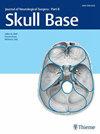在 NF2 患者前庭许旺瘤切除术中植入听性脑干的听力测定结果
IF 0.9
4区 医学
Q3 Medicine
引用次数: 0
摘要
背景:许多神经纤维瘤病 II 型(NF2)患者都患有感音神经性听力损失,NF2 患者的耳蜗神经受损使得听性脑干植入术(ABI)成为一种极具吸引力的治疗方案。该设备的长期疗效和益处仍在探索之中。 方法:在2017年11月至2022年8月期间,对一家单一机构三级中心的11名ABI接受者进行了回顾性审查。纳入的患者均被诊断为 NF2,并因同时患有前庭分裂瘤(VS)而接受切除术。回顾了听力测定前后的评估。评估包括纯音测听和言语测试。 结果:我们的队列包括 11 名患者,中位年龄为 34 岁。所有患者均接受了迷宫外植入术,并同时进行了 VS 切除术。VS 肿瘤的平均大小为 2.87 厘米。术前,8 名患者的纯音平均值(PTA)为 110 分贝无反应,2 名患者为轻中度听力损失(25-45 分贝),1 名患者的纯音平均值为极重度听力损失(92 分贝)。术后,9 名患者(81%)的 PTA 有所改善。共有 7 名患者报告了 ABI 激活后的轻微副作用,包括头晕(2 人)、耳鸣(1 人)、腹部和下肢刺痛感(3 人)。在 7 名有 ESP 评分的患者中,有 5 人的 ESP 评分超过 75%,这表明仅通过 ABI 的听觉刺激就能检测到听觉模式感知能力。 结论:11 名患者中有 9 人从植入 ABI 中获益。这些研究结果表明,在同时进行的VS切除术中植入ABI可为NF2患者带来显著的听力益处。本文章由计算机程序翻译,如有差异,请以英文原文为准。
Audiometric Outcomes of Auditory Brainstem Implantation During Vestibular Schwannoma Resection in NF2 Patients
Background: Many patients with neurofibromatosis type II (NF2) suffer from sensorineural hearing loss, and associated cochlear nerve compromise in NF2 patients makes auditory brainstem implant (ABI) an attractive treatment option. The long-term outcomes and benefits of the device are still being explored. Methods: A retrospective review was conducted for 11 ABI recipients at a single institution tertiary center between November 2017 to August 2022. Patients diagnosed with NF2 undergoing resection for concurrent vestibular schwannoma (VS) were included. Pre and post audiometric assessments were reviewed. Evaluation included pure-tone audiometry and speech testing. Results: Our cohort included 11 patients with a median age of 34 years old. All patients underwent a translabyrinthine approach for implant placement with concurrent VS resection. Average tumor size of VS was 2.87 cm. Pre-operatively, 8 patients had pure tone averages (PTA) with no response at 110 dB, 2 were within mild-moderate hearing loss (25-45 dB), and one patient had a PTA of profound loss (92 dB). Post-operatively, 9 (81%) patients had improvement in PTA. In total, 7 patients reported mild side effects upon ABI activation which included dizziness (n=2), tinnitus (n=1), and abdominal and lower extremity tingling sensation (n=3). Of the 7 patients with ESP scores, 5 had a score >75%, indicating the auditory ability to detect pattern perception upon auditory stimulation through the ABI alone. Conclusions: Nine of 11 patients derived benefits from ABI placement. These findings demonstrate that ABI placement during concurrent VS resection can provide a significant hearing benefit for NF2 patients.
求助全文
通过发布文献求助,成功后即可免费获取论文全文。
去求助
来源期刊

Journal of Neurological Surgery Part B: Skull Base
CLINICAL NEUROLOGY-SURGERY
CiteScore
2.20
自引率
0.00%
发文量
516
期刊介绍:
The Journal of Neurological Surgery Part B: Skull Base (JNLS B) is a major publication from the world''s leading publisher in neurosurgery. JNLS B currently serves as the official organ of several national and international neurosurgery and skull base societies.
JNLS B is a peer-reviewed journal publishing original research, review articles, and technical notes covering all aspects of neurological surgery. The focus of JNLS B includes microsurgery as well as the latest minimally invasive techniques, such as stereotactic-guided surgery, endoscopy, and endovascular procedures. JNLS B is devoted to the techniques and procedures of skull base surgery.
 求助内容:
求助内容: 应助结果提醒方式:
应助结果提醒方式:


